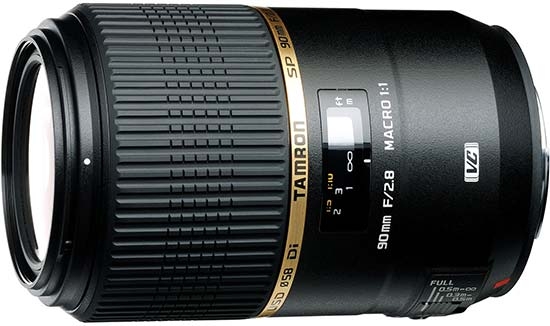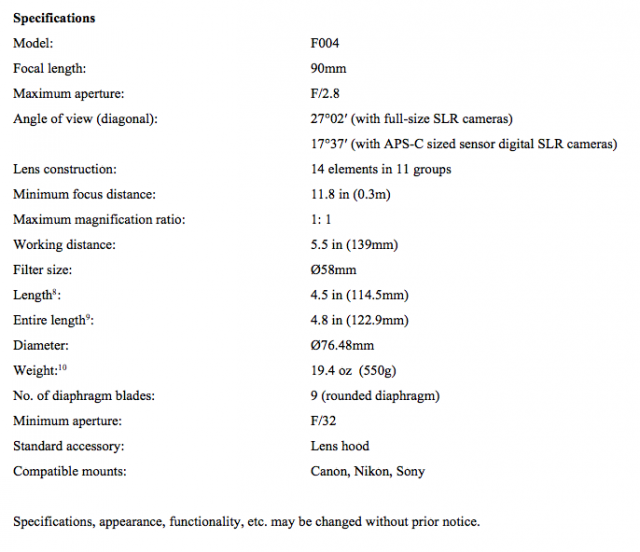
The Tamron SP 90mm F/2.8 Di VC USD lens is a new 1:1 macro lens that will be available for Canon, Nikon and Sony Alpha mount cameras later this year.
As with the new Tamron 70-200mm lens announced today, the Canon and Nikon mount version of this 90mm macro lens will features Tamron’s Vibration Compensation, while the Sony model will not due to the presence of Sony’s sensor-based SteadyShot image stabilization system. As such, the Sony models is designated as the Tamron SP SP 90mm F/2.8 Di USD.
Pricing for the new lens has not yet been announced. I would expect this lens to be priced in the $1000 range. The current non-VC Tamron 90mm macro lens retails for $499 at present.
More details in the press release below.
TAMRON ANNOUNCES DEVELOPMENT OF SP 90MM F/2.8 DI MACRO 1:1 VC USD (MODEL F004)
Redesign equips the legendary 90mm macro lens with VC (Vibration Compensation)[1] and USD (Ultrasonic Silent Drive)[2]
September 13, 2012, 4PM JST, Saitama, Japan – Tamron Co., Ltd. (President and CEO: Morio Ono / Headquarters: Saitama City), a leading manufacturer of optical equipment, announced the development of a next generation 90mm Macro lens for full-size SLR cameras. The lens features completely redesigned optics, a proprietary VC (Vibration Compensation), and USD (Ultrasonic Silent Drive). The SP 90mm F/2.8 Di VC USD will be available in Canon, Nikon and Sony[3] mounts. The lens is expected to ship by the end of 2012. Pricing information will be announced at a later date.
Product Features
Tamron has updated their legendary 90mm Macro lens with a new, state-of-the-art optical design. The lens, reborn for the age of digital photography, offers VC (Vibration Compensation) and USD (Ultrasonic Silent Drive).
Adopting a state-of-the-art optical design and a rounded diaphragm[4], this lens carries on the long tradition of Tamron’s 90mm Macro lens in delivering spectacular blur effects. Two XLD[5] (Extra Low Dispersion) glasses and one LD (Low Dispersion) element reduce chromatic aberrations, yielding sharp images and outstanding resolution.
Tamron’s newly developed eBAND (Extended Bandwidth & Angular-Dependency) Coating[6] delivers a dramatic improvement in antireflection performance-significantly reducing flare and ghosting for clearer, crisper images.
The VC (Vibration Compensation) image stabilization mechanism reduces camera shake to deliver sharp images.[7]
Features USD (Ultrasonic Silent Drive) to power a speedy AF drive together with a continuous manual focus mechanism.
Incorporates IF (Internal Focus) system, which focuses by moving only the internal lens group, rather than the front lens elements. The overall length of the lens therefore does not change when focusing, thus ensuring a broad working distance.
Moisture-resistant construction helps prevent moisture from penetrating the lens.

Notice of Classification Code Change for Nikon Mounts
Since the introduction by Tamron of the first Nikon mount lens featuring an internal AF motor, the 28-300mm Di VC (Model A20), all Nikon mount lenses with the internal AF motor had used the classification code “N II.” Lenses using a coupler system[11] without an internal AF motor were designated as “N.” Because future Nikon lenses will have the internal AF motor as a standard feature, Tamron has decided to simplify the designation and consolidate all Nikon mount lenses as “N,” eliminating the “N II” designation for future models. This classification code change was made effective with the 18-270mm Di II VC PZD (Model B008).
The “N” classification lenses with coupler systems (no internal AF motor) are: SP 200-500mm Di (Model A08); and SP 180mm F/3.5 Di (Model B01).
[1] VC (Vibration Compensation) is Tamron’s proprietary image stabilization mechanism.
[2] USD (Ultrasonic Silent Drive) is Tamron’s proprietary ultrasonic motor drive.
[3] The Sony mount does not include VC, as Sony digital SLR bodies include image stabilization functionality. The Sony lens is designated as “SP 70-200mm F/2.8 Di USD”
[4] This rounded diaphragm retains a nearly circular shape even when taken two stops down from its fully open state.
[5] The XLD (Extra Low Dispersion) glass is made from specialized high-grade glass, which offers greater chromatic aberration correction properties than LD (Low Dispersion) elements.
[6] The eBAND (Extended Bandwidth & Angular-Dependency) Coating is a new nanotechnology-based coating technique developed by Tamron to reduce unwanted reflection.
[7] From 3m, the benefits of VC (Vibration Compensation) gradually decrease as the focus distance becomes closer.
[8] Length, entire length and weight values given are for the Nikon mount.
[9] Entire length is the distance between the tip of the lens and the tip of the protrusion.
[10] Length, entire length and weight values given are for the Nikon mount.
[11] Coupler system refers to a system that uses a shaft to harness the AF motor built into the camera body to operate the lens.


I have a keen user of Tamron SP macro lenses for many years. I have always regarded their performance/price ratio to be exceptional. In everyday use, the sharpness and contrast has always been everything I can ask for. HOWEVER, if the addition of an image stabiliser doubles the price of the lens, then suddenly the economic case for buying it is not so clear cut. My personal experience is that in the real world I either A) work with electronic flash, so stabilisation isn’t the problem, or B) work with available light and life subjects where the issue is often subject movement rather than camera movement. It’s suddenly looking rather expensive, which is a pity. I wish them all success.
Will they ever get rid of the cheesy looking, gold ring?